If you are an engineer or shipping manager in aviation, you already know the importance of pinpointing a product or process solution in order to reduce our carbon footprint.
But do we as humans focus enough on the fundamental process of creating solutions or does our creativity become clouded by the obvious paths to becoming more energy efficient, earth-friendly, and keeping costs down? These are all amazing measurable goals, yet we continue down the same avenues year in and year out. In fact, “sustainability” has almost become a tired phrase. As we look deeper into how to approach sustainability in aviation, I would challenge the notion and say there is room for improvement in innovation, whether in the manufacturing environment or logistics.
Innovation in Aviation & Aerospace
Let’s step back for a moment to examine some of the greats in history. Braun’s laser-focused vision for the Saturn V rocket (giving momentum for NASA to reach the moon), Korolev’s infamous launch of Sputnik, and Rutan’s distinctive design of the Voyager were individual mile markers to achieve the same mission objective: Expand Space Exploration to the Unknowns. Yet, when it comes to 747’s and a company’s bottom line, why do we lose sight of out-of-the-box thinking? Innovation has always been at the core of an engineer’s job, so let’s explore some of the ways we can make the aviation industry 1% better every day. As they say, “There is no “i” in team,” but there are two in “creativity”—that is where you and I come in.
Approaches to Reducing Aviation Carbon Footprint
Considering the current methods to sustainability in aviation, these come to mind:
- Sustainable Aviation Fuel (SAF) or Alternative fuels
- Fuel-efficient Aircraft
- Route Optimization
- Efficiency Improvements such as Fueling Digitalization
These have been the backbone of inventiveness and optimization for decades, leading us to a place where we no longer feel the sky is the limit when it comes to sustainability. In fact, it almost feels as if we have reached some sort of ceiling with only minute improvements being possible on the horizon. We could always ask AI to speak as if it were Elon Musk in an attempt to expand our approach, but that would inevitably limit authentic idea generation, experimentation with prototypes, and the next, best inventions.
This begs the question, “Now what?” If the current innovations have given way to a lack of inventiveness, what is the next idea that we as engineers can pursue? And to that, why not consider something simple and unassuming, something outside the box of traditional innovation? Let’s consider parts transportation and the logistics surrounding it.
Transportation & Logistics as a means for sustainability
Enter Ecorrcrate. You probably saw this coming, but stick with me. Our innovative designs are up to 75% lighter than traditional solutions and, thanks to Devin, our GE & CFM Engine expert, they accommodate a large range of part sizes—especially those within a part “family.” This means you can say goodbye to excessive void fillers and bracing products.
Another major advantage? Companies can completely eliminate the need for spray foam. From the crate to the internal protection and closure system, every component is designed to be intuitive, fast, and easy to use. No more bulky crates or frantic searches for void fill. Our solutions are not only more sustainable, but they’re also faster to pack, making you more efficient and increasing your bottom line.
As an engineer, operations professional, or aviation specialist, you have the privilege of bringing new innovation to your organization. They may not be ready for the change, but are they ready for the savings?

